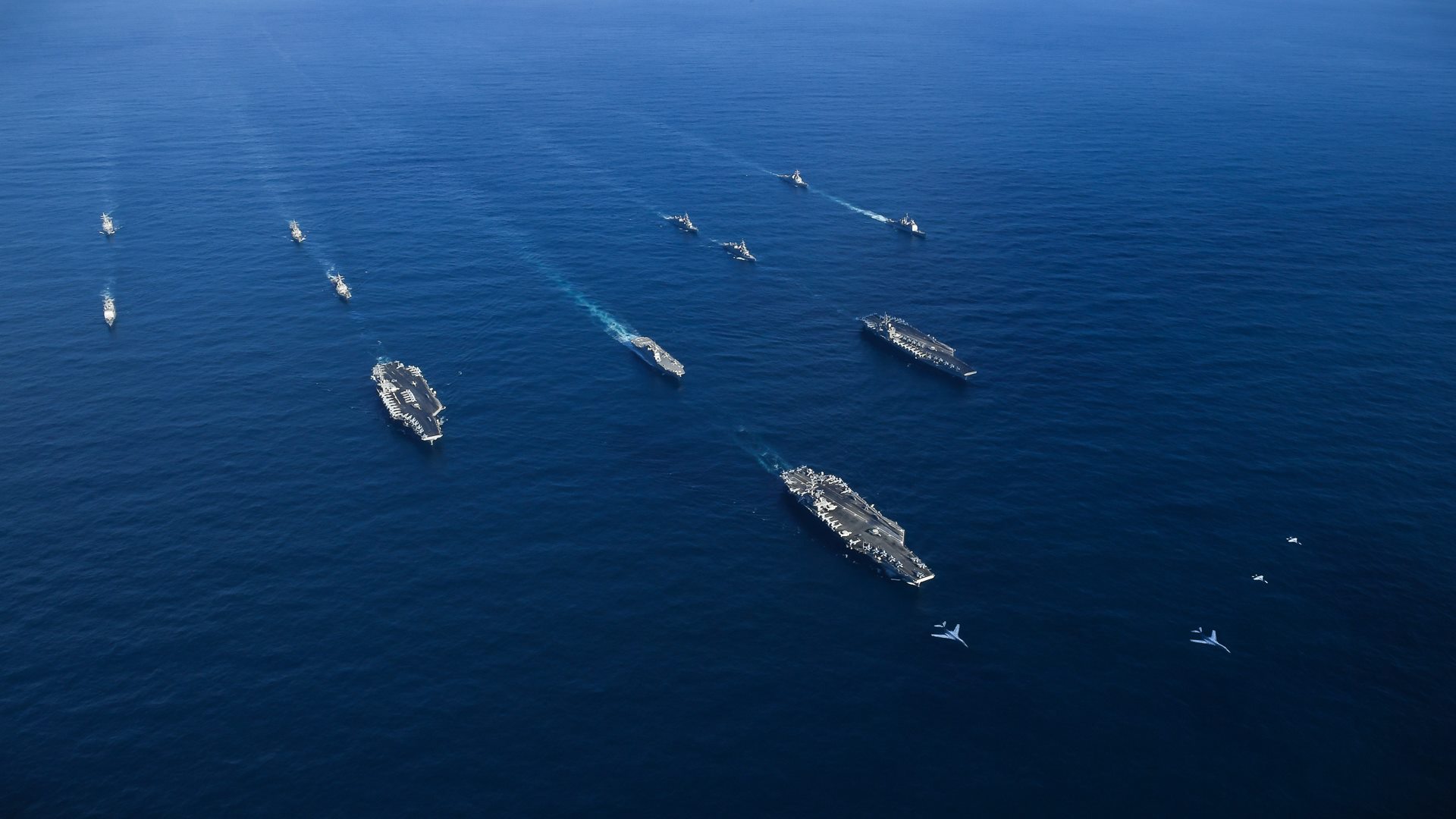
Three nuclear-powered supercarriers — Reagan, Roosevelt, and Nimitz — and their escorts exercise together in the Pacific.
WASHINGTON: WASHINGTON: The admiral leading the modernization of Navy’s manned and unmanned ships is looking back to the 1930s for the last time the service has faced the kinds of challenges it confronts today.
In the ’30s, the prevailing wisdom was, ‘’we will always fight fleet on fleet with battleships’” Vice Adm. Richard Brown, commander of Naval Surface Forces said. “And then World War II happened and we fought fleet on fleet with aircraft carriers.”
While he’s not advocating scuttling aircraft carriers or the 68 destroyers in the fleet today, Brown sees a similar dynamic unfolding with the development of unmanned surface vessels. “I think it’s entirely possible that we’ll fight fleet on fleet with unmanned surface vessels deep into that fight,” in future conflicts, he said.
Speaking with a small group of reporters in the run-up to this week’s Surface Navy conference in Washington, Brown offered few details on the progress he’s making on developing a plan for getting those unmanned surface vessels into the fleet, but it didn’t sound like anything that was likely to happen right away.
The admiral owes the Navy a report by April on how his team thinks USVs should be integrated into the fleet and how they will operate alongside manned ships, but he also suggested that it will be years before an armed, unmanned ship take to sea.
“They are going to come online, make no mistake about it. There will be weapons on board these things,” at some point, but Brown cautioned that is years away.
The Navy is expected to release its new concept for its future force structure in the coming weeks, but how many ships it will have and what mix of ships is in question. Given the relatively flat budgets expected in the coming years, the service has proposed slashing five of the 12 planned Flight III Arleigh Burke-class destroyers planned in the coming years, slowing the development of both the FFG(X) future frigate and the Block V Virginia-class submarine program, and speeding up the decommissioning of five cruisers and three dock landing ships.
But there are some serious politics in play.
President Trump campaigned in 2016 on the promise of building a 355-ship fleet, and his National Security Advisor, Robert O’Brien, has repeatedly pledged to get there. The Navy’s initial 2021 budget submission, however, actually shrank the fleet by three ships over the next five years due to budgetary constraints. Last month, the Office of Management and Budget ordered the Navy to come up with a plan “to achieve a 355-ship combined fleet, including manned and unmanned ships, by 2030.” To help the service boost the size of the fleet, OMB also ordered the Pentagon to submit a legislative proposal that would count certain unmanned ships as battleforce vessels, thereby bolstering the overall number and potentially reaching at least 355 hulls.
Acting Navy Secretary Thomas Modly recently tasked the Navy and Marine Corps with devising a plan to reach 355 ships within a decade, a tall order given the cost of building new ships, keeping older hulls at sea longer, and the repair and refit of an aging fleet.
“Whether the number’s 355, 365, 345, it’s somewhere around there,” Brown said. “We’ve got to get there. But ships are expensive, and crews are expensive. And so it’s really competing requirements and what’s valued most at the time the budgets are developed that determines,” the number of ships and size of the Navy overall.
While not committing to any set number of ships, Brown implied that the fleet in future years is going to have to change. Not only will unmanned ships have a large role to play in intelligence gathering out in front of carrier strike groups, but they’ll also provide a big punch at relatively little cost if armed with precision weapons.
“If we don’t push the boundaries, if we don’t develop the next large surface combatant, if we don’t develop [unmanned ships], if we don’t develop directed energy weapons, if we don’t go after conventional prompt strike, we could lose that premiere status” that the Navy has enjoyed since the end of World War II, Brown warned.
Major trends and takeaways from the Defense Department’s Unfunded Priority Lists
Mark Cancian and Chris Park of CSIS break down what is in this year’s unfunded priority lists and what they say about the state of the US military.


























